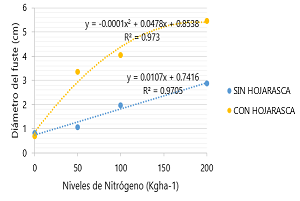Impact of organic fertilization and litter management of Marupa (Simarouba Amara) on the development of Palo de rosa (Aniba rosaeodora Ducke) in Yurimaguas
DOI:
https://doi.org/10.56926/repia.v1i2.19Keywords:
essential oils, plant biomass, forest species, cosmetic industry, organic nitrogenAbstract
Rosewood is a forest species in great demand for its essential oils, Linalol (85.8%), linoleic acid, alpha-terpineol (0.38%) and Geraniol (0.70%). The concentration of its oils depends on Nitrogen (N). The aim was to determine the effect of Marupa litter and the response of Rosewood to different doses of N applied as organic fertilizer in plants managed with and without litter cover. Also, determine the interaction between organic fertilization and litter management. The statistical design was divided plots, with the main plot being the factor with and without litter, the subplot being the doses of nitrogen equivalent to 0, 50, 100 and 200 kg per hectare. The results revealed that there are significant statistical differences (p=0.05) between the plants managed with and without litter. The increase in height, diameter and number of leaves per plant, was with the treatment of 200 kg of Nha-1, in the plots with and without litter management. The optimal dose of N to achieve the best yields in the evaluated variables was 168 Kg of Nha-1.
Downloads
References
Arce Urrea, C. (2007). Dinámica de descomposición y mineralización de macronutrientes en hojarasca de plantaciones de ormosia coccinea (aubl.) jackson, “Huayruro” y Vochysia Lomatophylla Standl, “Quillosisa’’’, Iquitos, Loreto, Perú.” Folia Amazónica, 16(1–2), 101. https://doi.org/10.24841/fa.v16i1-2.293
Bahamonde, H. A., Peri, P. L., & Mayo, J. P. (2014). Modelo de simulación de producción de materia seca y concentración de proteína bruta de gramíneas creciendo en bosques de Nothofagus antarctica (G. Forster) Oerst. bajo uso silvopastoril. Ecología Austral, 24(1), 111–117. https://doi.org/10.25260/ea.15.24.1.0.43
Colín Vargas, C. I., Domínguez Gómez, T. G., González Rodríguez, H., Cantú Silva, I., & Guadalupe Colín, J. (2018). Dinámica de nutrientes durante el proceso de degradación de la hojarasca en el Matorral Espinoso Tamaulipeco. Revista Mexicana de Ciencias Forestales, 9(49), 87–109. https://doi.org/10.29298/rmcf.v9i49.179
Cristóbal-Acevedo, D., Álvares-Sánchez, M. E., Hernández-Acosta, E., & Améndola-Massiotti, R. (2011). Concentración de Nitrógeno en suelo por efecto de manejo orgánico y convencional. Terra Latinoamericana, 29(3), 325–332. https://www.scielo.org.mx/scielo.php?script=sci_arttext&pid=S0187-57792011000300325
Dagnino, J. S. (2014). La distribución Normal. Revista Chilena de Anestesia, 43(2), 116–121. https://doi.org/10.25237/revchilanestv43n02.08
Gaspar-Santos, E. S., González-Espinosa, M., Ramírez-Marcial, N., & Álvarez-Solís, J. D. (2015). Acumulación y descomposición de hojarasca en bosques secundarios del sur de la Sierra Madre de Chiapas, México. Bosque (Valdivia), 36(3), 467–480. https://doi.org/10.4067/S0717-92002015000300013
Herrera Valencia, W., Barbosa Sampaio, P. de T., & Gomes de Souza, L. A. (2010). Crecimiento inicial de Palo de Rosa (Aniba rosaeodora Ducke) en distintos ambientes de fertilidad. Acta Amazonica, 40(4), 693–698. https://doi.org/10.1590/S0044-59672010000400008
Kometter, R. (2019). Diagnóstico general, poblaciones naturales de Aniba rosaeodora Ducke “Palo Rosa". Bio Modus Tropica, 1–47. https://n9.cl/pyf4o
Mallqui Espiritu, B. S. (2019). Efecto del compost y tamaño de hoyo en el crecimiento inicial de Schizolobium amazonicum Huber. ex Ducke “Pino Chuncho” en suelos degradados [Universidad Nacional Agraria de la Selva]. http://repositorio.unas.edu.pe/handle/UNAS/1514
Medrado Krainovic, P. (2017). Silvicultura de pau-rosa (Aniba rosaeodora Ducke): Alometria, manejo e produção de óleo essencial na Amazônia Central [Instituto Nacional de Pesquisas da Amazônia – INPA]. https://repositorio.inpa.gov.br/handle/1/4995
Mera, M. K., Ramirez, R., & Leiva, E. I. (2017). Importancia de la hojarasca en el cultivo de cacao (Theobroma cacao L.). International Symposiumu Cocoa Research (ISCR), 13–17. https://n9.cl/z6sygr
Queiroz Luz, J. M., Macedo Silva, S., Silva Soares, J., Camargo de Oliveira, R., Mayo Marques, M. O., & Facanali, R. (2016). Organic fertilization and composition of oregano essential oil. Boletin Latinoamericano y Del Caribe de Plantas Medicinales y Aromaticas, 15(5), 301–314. http://www.redalyc.org/articulo.oa?id=85647558003
Rengifo Salgado, E., & Campos Pérez, J. (2007). Perfil de plan de manejo de Palo de rosa (Aniba rosaeodora Ducke) (Issue 1, pp. 1–33). http://www.iiap.org.pe/upload/publicacion/PUBL1341.pdf
Requejo, A. (2020). Aceites Esenciales en Sinergia (1st ed.). ExLibric.
Rios Escobar, L. K. (2016). Producción y rendimiento de aceite de Aniba rosaeodora Ducke “Palo Rosa” en la localidad de Tamshiyacu, distrito de Fernando Lores, Loreto - Perú. [Universidad Nacional de la Amazonía Peruana]. http://repositorio.unapiquitos.edu.pe/handle/20.500.12737/4336
Rodríguez Balboa, P. C., González Rodríguez, H., Cantú Silva, I., Pando Moreno, M., Marmolejo Monsiváis, J. G., Gómez Meza, M. V., & Lazcano Cortez, J. (2019). Modelos de degradación de la hojarasca en bosques de encino y de pino en Nuevo León. Revista Mexicana de Ciencias Forestales, 10(55). https://doi.org/10.29298/rmcf.v10i55.548
Rodríguez Pleguezuelo, C. R., Durán Zuazo, V. H., Muriel Fernández, J. L., & Franco Tarifa, D. (2011). Descomposición de hojarasca y reciclado del nitrógeno de frutales tropicales y subtropicales en terrazas de cultivo en la costa de Granada (SE España). Comunicata Scientiae, 2(1), 42–48. https://n9.cl/htx32
Romero Mares, I. P. (2015). Métodos de Diseño y Análisis de Experimentos (pp. 1–26). Departamento de Probabilidad y Estadística IIMAS UNAM. http://sigma.iimas.unam.mx/patricia/disenos/notas/completamente_al_azar_1.pdf
Salcedo Pérez, E., Ruiz Blandon, B. A., Hernández Álvarez, E., González Cruz, R., Bernabé-Antonio, A., Orozco-Guareño, E., Ramírez-López, C. B., Hernández, J. A., & Delgado-Fornué, E. (2019). Propiedades del suelo y nitrógeno como indicadores del crecimiento en plantaciones comerciales de teca. Revista Mexicana de Ciencias Forestales, 10(52), 34–54. https://doi.org/10.29298/rmcf.v10i52.398
Tarrillo Ruíz, J. (2019). Ganancia genética esperada de Simarouba amara Aubl. (Marupa) en una plantación de la empresa bosques Amazónicos, Ucayali, Perú [Universidad Nacional de Ucayali]. http://repositorio.unu.edu.pe/handle/UNU/4235

Published
How to Cite
Issue
Section
License
Copyright (c) 2022 Luis Alberto Arévalo-López , Marco Jorge Luís Pérez-Echeverría, Jorge Miguel Pérez-Vela

This work is licensed under a Creative Commons Attribution 4.0 International License.
Authors retain their rights:
a. The authors retain the intellectual property rights (copyright) of the published works, assigning to the journal the right of first publication.
b. Authors retain their trademark and patent rights, and also on any process or procedure described in the article.
c. Authors retain the right to share, copy, distribute, perform and publicly communicate the article published in REPIA (e.g., place it in an institutional repository or publish it in a book), with an acknowledgement of its initial publication in REPIA.
d. Authors retain the right to make a subsequent publication of their work, to use the article or any part of it (e.g., a compilation of their work, notes for conferences, theses, or for a book), provided they indicate the source of publication (authors of the work, journal, volume, number, and date).







